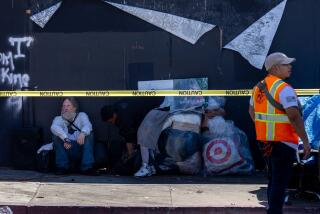Crackdown Demanded on Skid Row Camps
- Share via
A group of downtown Los Angeles civic leaders and residents on Monday said the growing homeless population on skid row is a public health and safety catastrophe and proposed that the city enact an anti-encampment ordinance and other measures to improve conditions.
The Central City Assn., backed by City Council members Jan Perry and Tom La Bonge, Police Chief William J. Bratton and several other advocacy groups, said the number of homeless living in squalor on downtown streets -- many with severe mental illnesses and addictions -- has reached crisis proportions and is threatening downtown’s economic revitalization.
Some agencies that provide services to the homeless, however, denounced the plan, saying it was merely another attempt to sweep the streets of homeless people who have nowhere else to go.
Putting an exclamation point on the concerns, Bratton said the concentration of homeless downtown is worse than he has seen in New York or Boston.
According to city counts conducted for the 2000 Census, from 9,000 to 15,000 people live on the streets of central Los Angeles, said Perry, as many as 3,000 to 5,000 of them on the 50 square blocks of downtown’s skid row. At the same time, the city is trying to attract new residents to live in renovated loft buildings in the area.
At a news conference at the newly rehabilitated Farmers and Merchants Bank building on skid row’s edge, the Central City Assn. and its allies asserted that current ordinances are ineffective in preventing public urination and defecation, camping on sidewalks and aggressive panhandling.
“We are focusing on a portion of the problem that no one has wanted to talk about, those dwelling on the streets who have set up tents and boxes,” said Central City Assn. President Carol Schatz. “We need to address that kind of behavior because it takes the streets away from all of us.”
Her group is proposing a plan it says will improve the quality of life downtown while also showing compassion for the truly sick and needy.
Besides the anti-encampment ordinance, proposals include:
* Specific city bans on public urination and defecation. The acts currently fall under the category of a nuisance crime, but are rarely prosecuted, say civic officials.
* Creation of an LAPD street-crime patrol with the purpose of catching drug dealers and other criminals who prey on the homeless.
* A city-financed downtown community court that would review petty crimes and divert homeless offenders to social service agencies rather than send them to jail.
* Audits of the Los Angeles Homeless Services Agency and individual service providers so they are held accountable for spending government funds effectively on housing, counseling, job training or other programs.
* City- and county-funded treatment for recovering homeless drug and alcohol addicts.
* Coordination among law enforcement agencies to release prisoners and parolees back into the communities where they were arrested rather than dumping them downtown, as is now common practice.
Bratton said he is studying proposals to beef up patrols downtown but made no commitment.
The new police chief, who is staying in a downtown hotel until he finds a permanent home, said he and his wife had been accosted by aggressive panhandlers several times while shopping.
Over the weekend, a man being ejected from a skid row transient hotel was stabbed to death with an ice pick, Bratton said.
As New York commissioner, Bratton was credited with cracking down on nuisance crimes such as panhandling and enforcing bans on sleeping on the streets. “If left unchecked these behaviors destroy neighborhoods, destroy cities and that’s what’s happening right outside this door,” he said.
Other California cities, such as San Francisco and Santa Monica, are getting tougher on squalid street conditions associated with some homeless people.
Some advocacy groups, however, said the Central City Assn. plan fails to address the lack of shelter beds that leads many homeless to sleep on the streets and said the group is motived by the economic interests of its members.
“Most addicts and mentally ill are not service-resistant,” said Gilbert Saldate, homeless coordinator for the Tri-City Mental Health agency. “They want housing and supportive services desperately. What they are resistant to are the rules, penalties and sanctions that some service providers and governmental agencies put in their way.”
Bob Erlenbusch, executive director of the Coalition to End Hunger and Homelessness, added: “Our position has always been framed by compassion in the deepest sense of the word. We defend people’s right to sleep outside when there is no alternative.”
But Perry said a downtown redevelopment plan could provide needed money for shelter, housing and social programs, and she lambasted advocacy groups, including the Homeless Coalition, that have sued the city to block it.
“I’m very hopeful we’ll settle these lawsuits very soon so we can stop wasting time,” said Perry, who called the situation on skid row a “catastrophe.”
“It’s neither compassionate nor humane to argue people have the right to live on the streets in their own waste.”
More to Read
Sign up for Essential California
The most important California stories and recommendations in your inbox every morning.
You may occasionally receive promotional content from the Los Angeles Times.











